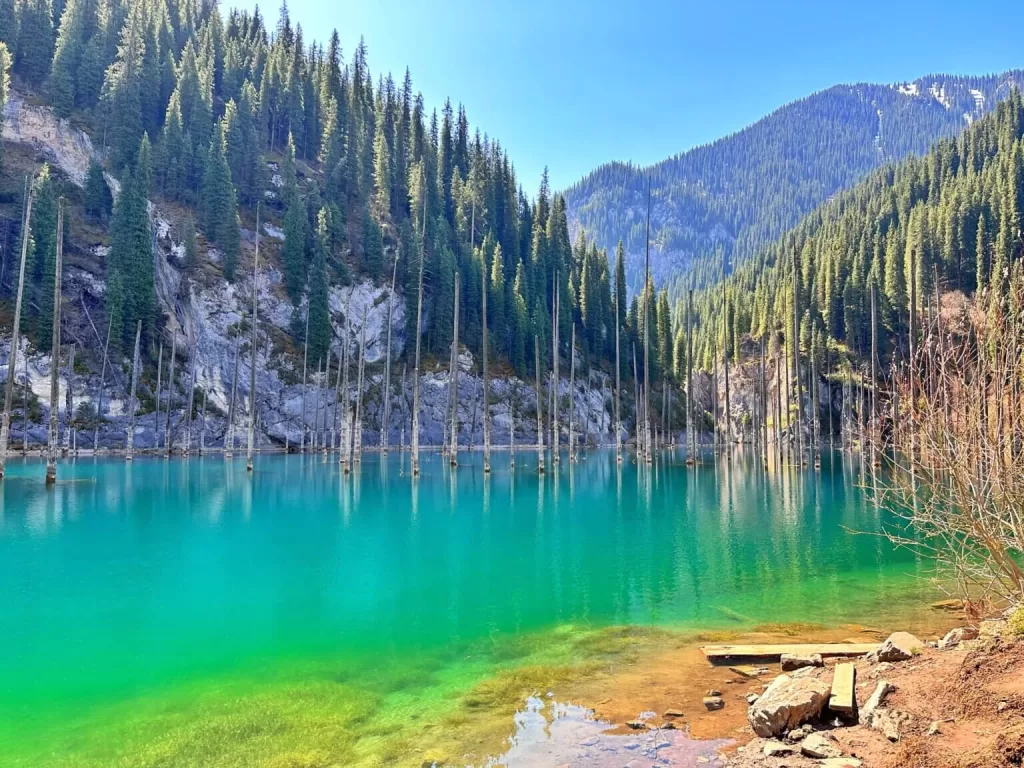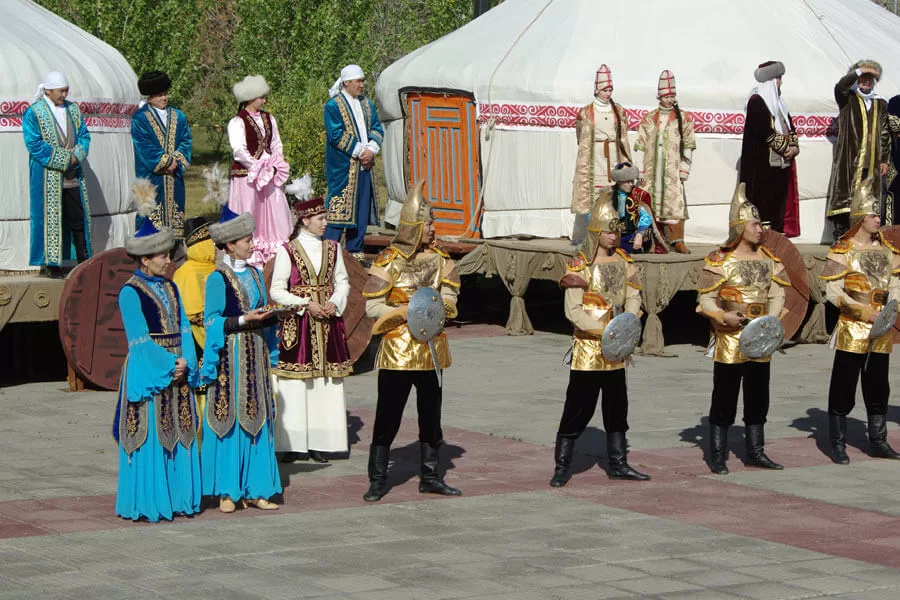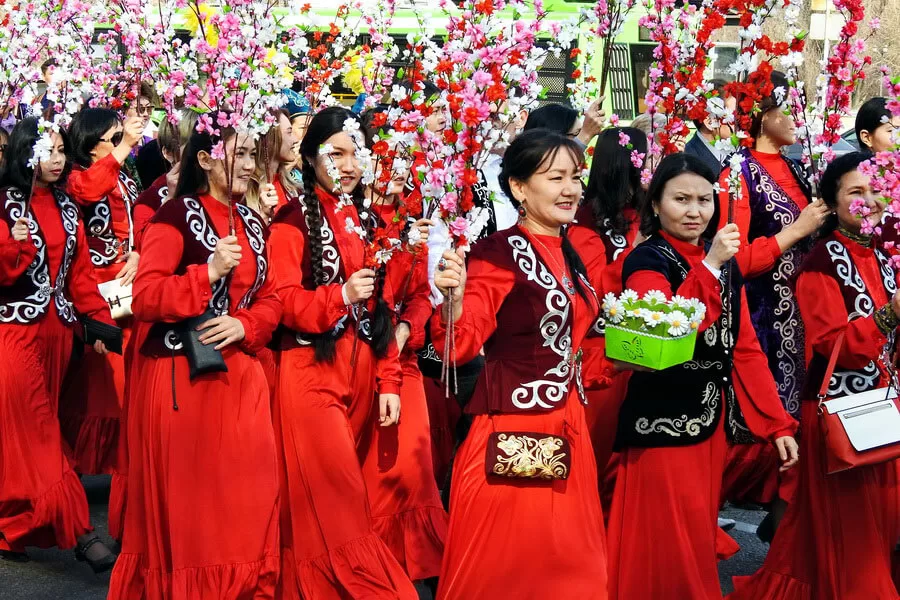How to Plan the Perfect Trip to Kazakhstan

Photo Credit: Hopping-Feet
Plan the Perfect Trip to Kazakhstan the ninth largest country in the world, renowned for its rich cultural legacy, varied landscapes, and nomadic customs.
From the broad steppes of the Kazakh Steppe to the towering peaks of the Tien Shan Mountains, Kazakhstan offers visitors a singular fusion of modern development, natural beauty, and antiquated history.
Climate and Geography

Photo Credit: About Kazakhstan
Kazakhstan is a large country in Central Asia that is bounded to the north by Russia, to the east by China, to the south by Kyrgyzstan, Uzbekistan, and Turkmenistan, and to the west by the Caspian Sea.
The topography of the nation is made up of a variety of environments, such as lakes, steppes, mountains, and deserts.
Southeast-based Tien Shan Mountains: These mountains provide breathtaking views and opportunities for outdoor pursuits like hiking, skiing, and mountaineering.
Steppe of Kazakhstan: The steppe, a huge grassland that spans most of the country’s central and northern areas, is the home of centuries-old nomadic cultures.
Caspian Sea: The western part of Kazakhstan is bordered by the world’s biggest inland body of water, the Caspian Sea, which provides recreational and fishing opportunities.
Kazakhstan has harsh continental weather, with chilly winters and scorching summers. The region and the things you want to do will determine when is the best time to come.
While winter (December to February) is good for skiing and winter activities in the south, summers (June to August) are best for visiting hilly locations.
Consider Heritage and Culture As You Plan the Perfect Trip to Kazakhstan

Photo Credit: Advantour
A rich tapestry of diverse ethnic traditions, including Kazakh, Russian, Uzbek, and others, make up Kazakhstan’s cultural legacy. Kazakh culture still retains many elements of its nomadic past, from music and dance to food and hospitality.
Traditional Dance and Music: The dombra, a two-stringed instrument, and throat singing are hallmarks of Kazakh music. The nomadic way of life is reflected in traditional dances like the lezginka and the Kazakh kara zhorga, or blacksmith’s dance.
Cuisine: The substantial dishes of Kazakh cuisine, such as Beshbarmak (boiled meat with noodles), Shashlik (grilled meat skewers), and Kazy (horse sausage), are influenced by the nomadic lifestyle.
Nomadic Heritage: A look into Kazakhstan’s past is provided by the continued practice of nomadic customs like yurt living, horseback riding, and eagle hunting in rural areas.
Festivals & Celebrations: Traditional rituals, music, and feasting are used to celebrate Kazakh festivals, like Nauryz (New Year) and Kurban Ait (Eid al-Adha), which offer a fantastic chance for cultural immersion.
Best Places to Go
Kazakhstan has a wide variety of attractions, ranging from contemporary cities to historic locations and breathtaking natural formations. Here are a few highly recommended places to visit:
Almaty
Kazakhstan’s largest city, Almaty, is a thriving metropolis tucked away at the base of the Tien Shan Mountains. Almaty offers guests a singular fusion of urban refinement and outdoor adventure with its dynamic cultural scene, contemporary conveniences, and close proximity to nature.
The world’s highest-altitude skating rink, Medeu, is situated outside of Almaty and provides stunning views of the surrounding mountains.
Shymbulak Ski Resort is a well-known ski resort close to Medeu that provides top-notch facilities for snowboarding and skiing in the winter.
Big Almaty Lake: Known for its picturesque hiking routes and turquoise waters, Big Almaty Lake is a breathtaking alpine lake located in the Ile-Alatau National Park.
Zenkov Cathedral, a stunning Russian Orthodox church in the center of Almaty, is sometimes referred to as the Ascension Cathedral.
Nur-Sultan, formerly known as Astana, is Kazakhstan’s capital city and a cutting-edge center of innovation, culture, and architecture. Nur-Sultan gives tourists a peek of Kazakhstan’s hopes for the future with its futuristic cityscape, imposing government buildings, and lively cultural scene.
Shymkent
Southern Kazakhstan’s Shymkent is a bustling city renowned for its varied cultures, long history, and friendly people. With its historic sites, vibrant bazaars, and energetic street life, Shymkent gives tourists a window into the spirit of Kazakhstan.
Local History and Regional Museum: With displays and relics, the Regional Museum of Local Lore—located in the center of Shymkent—presents the history, customs, and culture of the area.
Independence Park: A well-liked recreation spot in Shymkent, Independence Park has a charming lake, walking trails, and an abundance of greenery where people congregate to unwind and mingle.
Explore Shymkent’s Old Town, a historic district with typical adobe homes, medieval mosques, and winding cobblestone lanes dotted with cafes and stores.
Turkestan: The Mausoleum of Khoja Ahmed Yasawi, one of Kazakhstan’s most significant religious sites and a UNESCO World Heritage Site, is located in Turkestan, a short drive from Shymkent.
Baikonur Cosmodrome
The first and biggest operational space launch facility in the world is Baikonur Cosmodrome, which is situated in southern Kazakhstan. As the starting point for many important space missions,
Baikonur has been essential to humanity’s exploration of space since the beginning of the space race.
Tours of the Launch Pad: When visiting Baikonur, tourists can go on guided tours of the launch pads, control centers, and other buildings to see rocket launches and discover more about the space exploration past.
Space Museum: From the early years of the Soviet space program to the present, the Baikonur Cosmodrome Museum’s exhibits and displays trace the history of space exploration.
Canyon Charyn
The Charyn Canyon, a natural marvel in eastern Kazakhstan, is sometimes called the “Grand Canyon of Central Asia.” With its deep canyons, spectacular panoramas, and amazing rock formations, the canyon was sculpted over millions of years by the Charyn River.
Castle Valley: The Valley of Castles, where towering rock formations resemble old fortresses and citadels, is one of Charyn Canyon’s most striking attractions.
Hiking paths: There are a lot of hiking paths in Charyn Canyon that range in difficulty, allowing hikers to explore the canyon’s various ecosystems and vistas.
Camping: Among the breathtaking natural surroundings of Charyn Canyon, camping is a popular activity. Designated campsites are available for overnight stays.
Rafting: The Charyn River provides opportunities for white-water rafting in the spring and early summer, giving travelers an exciting way to take in the grandeur of the canyon
Lake Kolsai
Three alpine lakes known for their pristine waters, verdant woods, and breathtaking mountain vistas may be found in the northern Tien Shan Mountains. These lakes are called the Kolsai Lakes. The Kolsai Lakes, encircled by snow-capped peaks and pure environment, provide adventure enthusiasts and nature lovers with a peaceful haven.
Hiking: There are several beautiful hiking paths crisscrossing the area around the Kolsai Lakes, ranging from short strolls to strenuous hikes that lead to panoramic overlooks and hidden waterfalls.
Fishing: In the clean, mountain-fed waters of the Kolsai Lakes, anglers can catch trout and other freshwater species. Fishing is a favorite pastime there.
Riding a Horse: Ride a horse and take in the stunning scenery of the Kolsai Lakes, traversing paths that meander through pastures, meadows, and woodlands.
Photography: From reflections in the glistening waters to striking sunsets over the neighboring mountains, the Kolsai Lakes present photographers with countless chances to capture the beauty of nature.
Cultural Experiences
Kazakhstan offers visitors a wide variety of cultural activities in addition to its stunning natural surroundings, including traditional music and dance, nomadic heritage, and delectable cuisine.
Traditional Dance and Music of Kazakhstan
The dombra, a two-stringed lute, and the kobyz, a traditional Kazakh violin, are two examples of the traditional instruments that commonly accompany the catchy tunes, rhythmic beats, and poignant lyrics that define Kazakh music. a vital component of Kazakh cultural expression, traditional dances like the lezginka, a vibrant Caucasian dance, and the kara zhorga, a blacksmith’s dance, are frequently performed at festivals, weddings, and other special occasions.
Nomadic Heritage
For millennia, Kazakh culture has been heavily influenced by nomadic traditions, which have shaped everything from everyday life to social rituals and traditions.
By living in authentic yurts, which are movable round tents, watching eagle hunting exhibitions, and learning about the art of horseback riding from knowledgeable nomadic horsemen known as kokpar, visitors visiting Kazakhstan can get a personal look at the nomadic way of life.
Kazakh Food
The robust dishes in Kazakh cuisine are a reflection of the nation’s nomadic past, as they were created to support herders and travelers in the hardy steppe environment.
Popular dishes in Kazakh cuisine that feature meat include Beshbarmak, which is boiled meat with noodles, Shashlik, which is grilled meat skewers, and Kazy, which is horse sausage.
Other delectable treats are Kurt (dry sour milk balls), Manty (dumplings stuffed with meat or vegetables), and Baursaks (fried dough).
Celebrations and Festivals

Photo Credit: Advantour
Kazakhstan’s rich cultural heritage and customs are a unique chance for visitors to experience, as the country’s calendar is brimming with festivals and celebrations.
Nauryz, the Kazakh New Year, is one of the most significant celebrations. It is marked with customary ceremonies, music, dance, and food.
Other celebrations include the Muslim community’s Kurban Ait (Eid al-Adha) and a number of regional celebrations that highlight regional traditions, handicrafts, and cuisine.
Useful Advice for Travelers
It is imperative that you plan and get ready for the special chances and challenges that Kazakhstan offers before you travel there.
Kazakhstan is a diversified and dynamic country.
Entry and Visa Requirements
In order to enter Kazakhstan, you might require a visa, depending on your nationality. Make sure your passport is valid for at least six months beyond your intended departure date and check the visa requirements well in advance of your trip.
Transportation
Trains, buses, domestic flights, and rental automobiles are all part of Kazakhstan’s well-established transportation network.
Trains are a common and convenient means of transportation between cities, with frequent services linking important locations.
For shorter distances, buses are also an option and are less expensive than trains.
Renting a car gives you the freedom to travel at your own speed in isolated locations and off-the-beaten-path destinations, but be ready for lengthy drives and uneven roads.
Weather
The country of Kazakhstan has a continental climate, with scorching summers and chilly winters. The region and the things you want to do will determine when is the best time to come. Winter (December to February) is suitable for skiing and winter sports in the south, while summers (June to August) are great for outdoor activities and visiting hilly locations.
Spring (March to May) and fall (September to November) are great periods to come because of the nice weather and lack of crowds.
Language
Although Russian and Kazakh are the official languages of Kazakhstan, English is becoming more and more common, particularly in popular tourist destinations and large cities.
Acquiring some basic knowledge in Kazakh or Russian might improve your trip and foster relationships with locals, who value your effort in speaking their language.
Currency
The Kazakhstani Tenge (KZT), which is issued in coins and banknotes, is the country’s currency.
Major cities and towns have plenty of ATMs, but when visiting outlying locations, where credit cards might not be accepted, it’s best to have cash.
You can guarantee the best rates and minimize the chance of receiving counterfeit money by exchanging your money at banks or authorized exchange bureaus.
.
I will help you travel far, travel wide, and travel without regret. Find life in the journey, not the destination explore dream and discover places your ever dream to be
